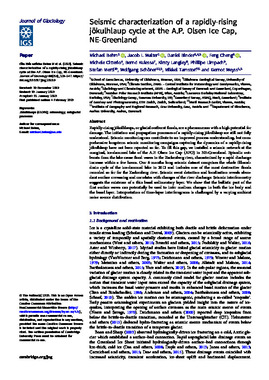| dc.contributor.author | Behm, Michael | |
| dc.contributor.author | Walter, Jacob I. | |
| dc.contributor.author | Binder, Daniel | |
| dc.contributor.author | Cheng, Feng | |
| dc.contributor.author | Citterio, Michele | |
| dc.contributor.author | Kulessa, Bernd | |
| dc.contributor.author | Langley, Kirsty | |
| dc.contributor.author | Limpach, Phillipe | |
| dc.contributor.author | Mertl, Stefan | |
| dc.contributor.author | Schöner, Wolfgang | |
| dc.contributor.author | Tamstorf, Mikkel | |
| dc.contributor.author | Weyss, Gernot | |
| dc.date.accessioned | 2020-04-30T20:58:58Z | |
| dc.date.available | 2020-04-30T20:58:58Z | |
| dc.date.issued | 2020-02-04 | |
| dc.identifier.citation | Behm M et al. (2020). Seismic characterization of a rapidly-rising jökulhlaup cycle at the A.P. Olsen Ice Cap, NE-Greenland. Journal of Glaciology 66(256), 329–347. https:// doi.org/10.1017/jog.2020.9 | en_US |
| dc.identifier.uri | https://hdl.handle.net/11244/324156 | |
| dc.description.abstract | Rapidly-rising jökulhlaups, or glacial outburst floods, are a phenomenon with a high potential for damage. The initiation and propagation processes of a rapidly-rising jökulhlaup are still not fully understood. Seismic monitoring can contribute to an improved process understanding, but comprehensive long-term seismic monitoring campaigns capturing the dynamics of a rapidly-rising jökulhlaup have not been reported so far. To fill this gap, we installed a seismic network at the marginal, ice-dammed lake of the A.P. Olsen Ice Cap (APO) in NE-Greenland. Episodic outbursts from the lake cause flood waves in the Zackenberg river, characterized by a rapid discharge increase within a few hours. Our 6 months long seismic dataset comprises the whole fill-and-drain cycle of the ice-dammed lake in 2012 and includes one of the most destructive floods recorded so far for the Zackenberg river. Seismic event detection and localization reveals abundant surface crevassing and correlates with changes of the river discharge. Seismic interferometry suggests the existence of a thin basal sedimentary layer. We show that the ballistic part of the first surface waves can potentially be used to infer medium changes in both the ice body and the basal layer. Interpretation of time-lapse interferograms is challenged by a varying ambient noise source distribution. | en_US |
| dc.description.sponsorship | JIW was supported by the National Science Foundation Office of Polar Programs Award 1745135. Open Access fees paid for in whole or in part by the University of Oklahoma Libraries. | en_US |
| dc.language | en_US | en_US |
| dc.rights | Attribution-NonCommercial-ShareAlike 4.0 International | * |
| dc.rights.uri | https://creativecommons.org/licenses/by-nc-sa/4.0/ | * |
| dc.subject | Jökulhlaups (GLOFs) | en_US |
| dc.subject | seismology | en_US |
| dc.subject | subglacial processes | en_US |
| dc.title | Seismic characterization of a rapidly-rising jökulhlaup cycle at the A.P. Olsen Ice Cap, NE-Greenland | en_US |
| dc.type | Article | en_US |
| dc.description.peerreview | Yes | en_US |
| dc.identifier.doi | 10.1017/jog.2020.9 | en_US |
| ou.group | Mewbourne College of Earth and Energy::School of Geosciences | en_US |

